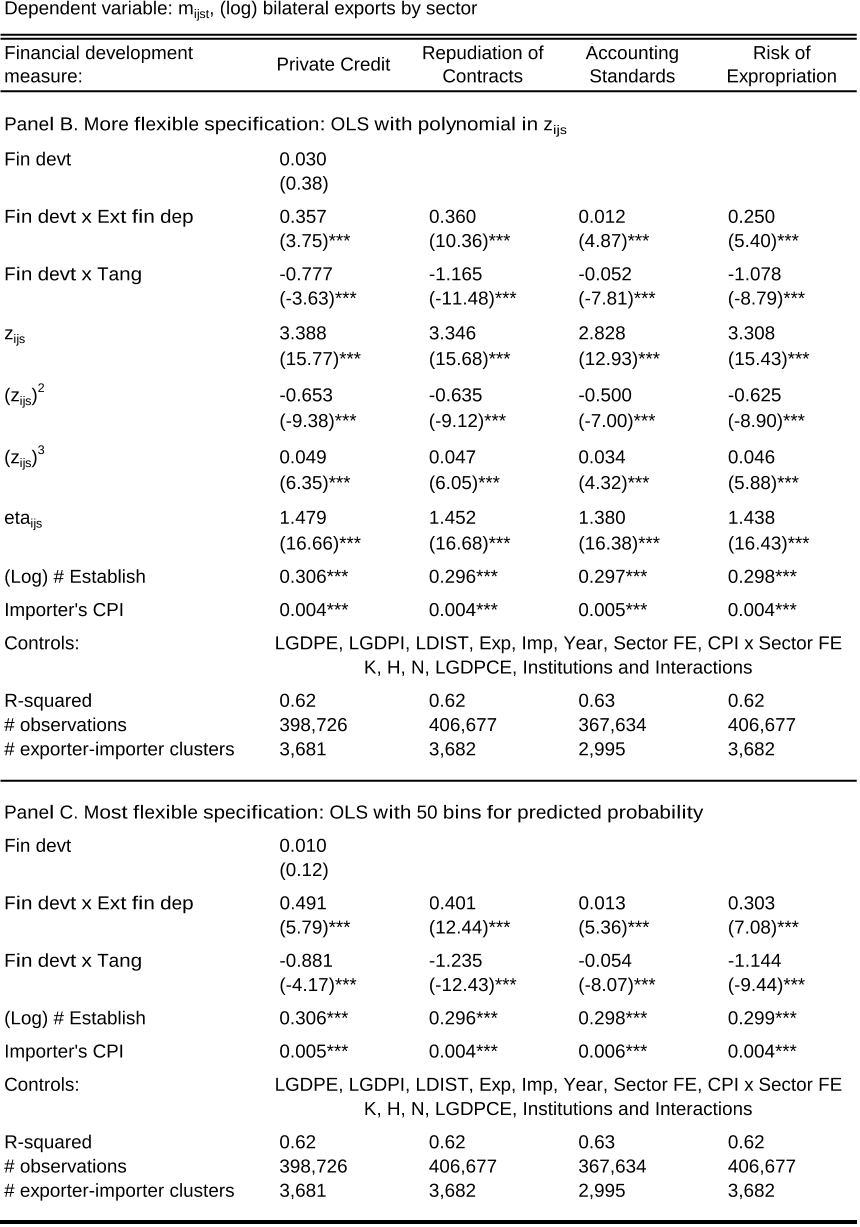Credit Constraints, Heterogeneous Firms and International Trade
Reads0
Chats0
TLDR
This article examined the detrimental consequences of financial market imperfections for international trade and developed a heterogeneous-firm model with countries at different levels of financial development and sectors of varying financial vulnerability.Abstract:
This paper examines the detrimental consequences of financial market imperfections for international trade. I develop a heterogeneous-firm model with countries at different levels of financial development and sectors of varying financial vulnerability. Applying this model to aggregate trade data, I study the mechanisms through which credit constraints operate. First, financial development increases countries' exports above and beyond its impact on overall production. Firm selection into exporting accounts for a third of the trade-specific effect, while two thirds are due to reductions in firm-level exports. Second, financially advanced economies export a wider range of products and their exports experience less product turnover. Finally, while all countries service large destinations, exporters with superior financial institutions have more trading partners and also enter smaller markets. All of these effects are magnified in financially vulnerable sectors. These results have important policy implications for less developed economies that rely on exports for economic growth but suffer from poor financial contractibility.read more
Figures

Table 10. Economic Significance: Predicted vs. Actual Trade Growth 
Table 9. Economic Significance: Comparative Statics 
Table 5. Financial Development and Firm-Level Exports 
Figure 3. The Productivity Cut-off for Exporting 
Table 5. Financial Development and Firm-Level Exports 
Table 1. Export Patterns in the Data
Citations
More filters
Posted Content
Estimating Trade Flows: Trading Partners and Trading Volumes
TL;DR: In this paper, the impact of trade frictions on trade flows can be decomposed into the intensive and extensive margins, where the former refers to the trade volume per exporter and the latter referred to the number of exporters.
Journal ArticleDOI
Finance and Development: A Tale of Two Sectors †
TL;DR: This article developed a model co-determining aggregate total factor productivity (TFP), sectoral TFP, and scales across industrial sectors and found that financial frictions disproportionately affect TFP in tradable sectors where production requires larger costs.
Posted Content
Exports and Financial Shocks
Mary Amiti,David E. Weinstein +1 more
TL;DR: In this article, a causal link between the health of banks providing trade finance and growth in a firm's exports relative to its domestic sales is established, suggesting that trade finance accounts for about one-third of the decline in Japanese exports in the financial crises of the 1990s.
Journal ArticleDOI
Off the Cliff and Back? Credit Conditions and International Trade During the Global Financial Crisis
TL;DR: This article studied the collapse of international trade flows during the global financial crisis using detailed data on monthly US imports and showed that credit conditions were an important channel through which the crisis affected trade volumes, by exploiting the variation in the cost of capital across countries and over time.
Journal ArticleDOI
The Empirics of Firm Heterogeneity and International Trade
Andrew B. Bernard,Andrew B. Bernard,Andrew B. Bernard,J. Bradford Jensen,J. Bradford Jensen,Stephen J. Redding,Peter K. Schott,Peter K. Schott,Peter K. Schott +8 more
TL;DR: A review of empirical evidence on firm heterogeneity in international trade can be found in this article, where a first wave of empirical findings from micro data on plants and firms proposed challenges for existing models of international trade and inspired the development of new theories emphasizing firm heterogeneity.
References
More filters
Journal ArticleDOI
Optimal Lending Contracts and Firm Dynamics
TL;DR: In this paper, the authors developed a general model of lending in the presence of endogenous borrowing constraints, where the ability to raise short-term capital is limited by some prespecified function of debt.
Posted Content
Trading on Time
TL;DR: In this paper, the authors determined how time delays affect international trade, using newly-collected World Bank data on the days it takes to move standard cargo from the factory gate to the ship in 126 countries.
Posted Content
Credit Constraints, Equity Market Liberalizations and International Trade
TL;DR: In this paper, the authors exploit shocks to the availability of external finance and examine the impact of equity market liberalization on the export behavior of 91 countries in the 1980-1997 period, showing that liberalization increase exports disproportionately more in financially vulnerable sectors that require more outside finance or employ fewer collateralizable assets.
Journal ArticleDOI
The role of extensive and intensive margins and export growth
Tibor Besedes,Thomas J. Prusa +1 more
TL;DR: In this paper, the authors investigate and compare countries' export growth based on their performance at the extensive and intensive export margins, and find that developing countries would experience significantly higher export growth if they were able to improve their performance with respect to the two key components of the intensive margin: survival and deepening.
Posted Content
Financial Dependence and International Trade
Thorsten Beck,Thorsten Beck +1 more
TL;DR: The authors used industry-level data on firms' dependence on external finance for 36 industries and 56 countries to examine this question and found that countries with better-developed financial systems have higher export shares and trade balances in industries that use more external finance.